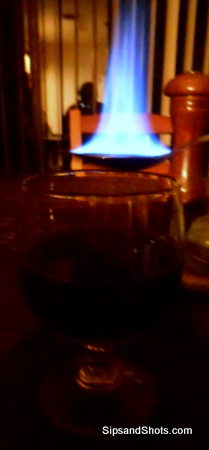When it comes to honoring other culture’s holy days with something as potentially flippant as a cocktail tribute, you have to walk a fine line between humor and reverence. So I’m going to apologize now for the very bad pun I’m about to make.
Most people know that Hanukkah is the Jewish celebration of the night when they had only enough oil for 1 night and yet it lasted a full 8. It is that, as well as the celebration of the re-dedication of the Temple of Jerusalem (which had been previously desecrated on the orders of Antiochus IV) after a several years of war. Because of that miracle, oil plays a significant part of the Hanukkah rituals and explains why the popular foods of the holiday are fried.
Oily (or unctuous) is not something we generally look for in cocktails. There is a way to merge the two; it’s a process called fat-washing (yes, it’s a gross name) and often includes bacon or other fatty meats. Somehow I didn’t think that bacon-bourbon would be… kosher for this festival.
Instead, I’m going to lead with wine.
The story of Judith is another told during this holiday (which, in 2012, starts at sunset on Saturday, December 8*), and one I was not aware of before now. Judith was a widow in a town beset by an Assyrian general and his troops and they were running out of options. She concocted a plan to “surrender” to this general (Holofernes), ply him with salty cheese to make him thirsty, and then get him drunk on wine. When he was out cold she cut off his head. His troops were a bit lost without their leader and the town was saved.
This is also where dairy foods–everything from the sour cream on the fried latkes to the cheese filling in the blintzes–comes into play in the Hanukkah celebration.
Growing up, one of our unofficial holiday traditions was to watch Peter, Paul, and Mary’s “A Holiday Celebration” on PBS (frequently as part of their annual pledge drive). I was always most impressed by the songs I hadn’t heard before, namely the Hanukkah songs (some, like Light One Candle, written by Paul Yarrow). They remain some of my holiday favorites.
To that end, I offer you
Light One Cocktail
1.5 oz Red Table Wine
1.5 oz Apple Juice
1 oz + 1 barspoon Honey Bourbon, divided
kitchen match or long-handled lighter
Combine the wine (check for Kosher or Pareve on the label if your guests are observant), juice, and single ounce of bourbon in a mixing glass with just a few ice cubes and stir until combined but not super-cold. Pour into a cocktail glass that has NOT been chilled. Hold the barspoon of bourbon over the cocktail glass and light it. Once you’ve been suitably impressed, carefully extinguish the flaming by dunking the flaming spirits into the drink.
Turning the lights off just before you flame it makes for a nice touch.
So we have the wine for Judith, the apple juice for another common accompaniment to latkes (applesauce), and the honey bourbon for the honey-dipped loukoumades that also make appearances at some Hanukkah celebrations.
I’ve never flamed a drink before tonight. To tell the truth, I was always a bit afraid to. Even though it’s a fairly common bar trick it’s not something I was too keen to play with. Still, it seemed appropriate, so we went for it. I’d read about a Russian custom** of dipping a piece of sugar into spirits, lighting them in a spoon and then dousing them in one’s tea once the holiday songs were sung; it seemed a somewhat safer way to approach the flaming drink idea.
Alas, the sugar cube method wouldn’t cooperate with this drink, and since the overall alcohol isn’t of a high enough proof to flame on its own, the barspoon of bourbon serves our purpose admirably.
What we do end up with, though, is a slightly sweet wine that will complement, I think, a plate of latkes admirably.
L’Chaim!
*yes, I know the calendars say the 9th, Jewish days start at sunset whereas the Gregorian calendar’s start at midnight
**http://www.cyber-kitchen.com/rfcj/HANUKKAH/Beverage_Flaming_Tea_-_pareve.html
